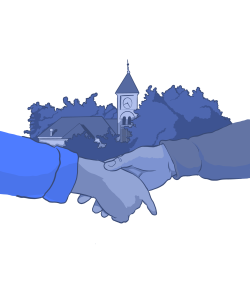Windows and Macintosh rule the campus, but pockets of alternative technologies and cutting edge applications can be found throughout Whitman.
“The faculty and student demand determines what services and equipment we provide,” said Shannon Callister, director of information technology support services. “We maintain the two operating systems that people are most used to.”
Institutional support for two different technologies is not standard at an institution like Whitman, according to Callister.
Of the 891 individual student computers registered with the college residence computer network, 52 percent run Microsoft Windows and 46 percent use Macintosh. Nationally Macintosh has only 4 percent market share.
The proportions of the available computers are determined according to demands of the particular location. According to Callister, the computer lab in Maxey Hall has only three Macintosh workstations because the faculty prefer programs used for the social sciences to run on Windows.
On the second floor of the Olin Hall the math department maintains an independent computer laboratory. All the computers run Linux operating system with several graphical interfaces available.
Unlike Macintosh and Windows, Linux is classified as open-source software. This status means that the source code that constitutes the program is openly available to the public free of charge and can be modified by the users.
“The lab is the home of computer sciences on campus,” said Albert Schueller, chair of the mathematics department. “Our academic requirements are too complicated for the WCTS to support easily.”
The lab also contributes to a healthy campus community of Linux users, according to the mathematics department Web site. Students not taking mathematics courses are welcome to use the lab. Interested students have to contact the department to get an account.
Around 50 people use Linux on their personal computers, according to Schueller.
The ability to make modifications was behind the college’s choice to switch to the open-source class content management system CLEo, according to the system’s manager Mike Osterman.
“Using open-source often makes good sense,” said Osterman. “Our costs have gone down and users have benefited.”
CLEo is based on the Sakai project, and Whitman belongs to the community of institutions that draw on the Sakai code for their individual system applications. Various components of the system are provided and maintained by various institutions in different parts of the world. The feature that provides automatic enrollment on CLEo was developed at Whitman.
Both open- and closed-source operating systems can be found on the servers that run the other college’s information systems.
“We look at what the server needs to do and select the best choice [of operating system],” wrote Kevin Kelly, director of network technology, in an e-mail.
The college pays a license fee for running closed-source software on servers or individual computers.
“Microsoft’s closed-source software is overpriced,” said senior Ryuhei Yokokawa.
Last year with Paul Carduner, a former Whitman student now working as a software developer, Yokokawa organized Software Freedom Day and distributed open-source programs and Linux Ubuntu, a particularly user-friendly Linux version.
“The more people know about open-source the less likely a corporation like Microsoft will take over the world,” said Carduner. “Open-source brings democracy to knowledge.”
The open-source concept can be applied to more than software. Whitman Direct Action, a student-run development group, strives to be the first ever open-source organization.
“I’m pretty sure we can make that claim because the technology to make it practical has only been around for less than a year,” wrote Daniel Bachhuber, former Whitman student and the technical administrator of the organization, in an e-mail.
All information regarding the organization’s structure, meeting minutes and project details is available on the organization’s Web site. Transparency, accountability and community involvement are the main benefits of the open-source structure, according to Bachhuber.
As Carduner sees it, the open-source movement is opening up society and education. He cites governments and industries moving toward more open software and document formats as reason for an educational institution like Whitman to embrace open-source.
“In 10 years you might be required by law to use open-source,” said Carduner.
The cost saving benefits of open-source technologies are appealing also to the non-governmental sector.
“Your open-source skills allow the organization save money and makes you a better candidate for the job,” said Yokokawa.
Schueller remains skeptical about the widespread acceptance of Linux but sees it as useful to those in technical careers.
“Switching to Linux is a steep learning curve,” said Joel Klipfel, a senior and a consultant at the math lab, who installed Linux on his computer after he enrolled at Whitman.
The pro-Linux advocates and college staff agree that more open-source technologies will be available if there is demand from students and the faculty. “WCTS are proud to pursue open-source,” said Callister.










